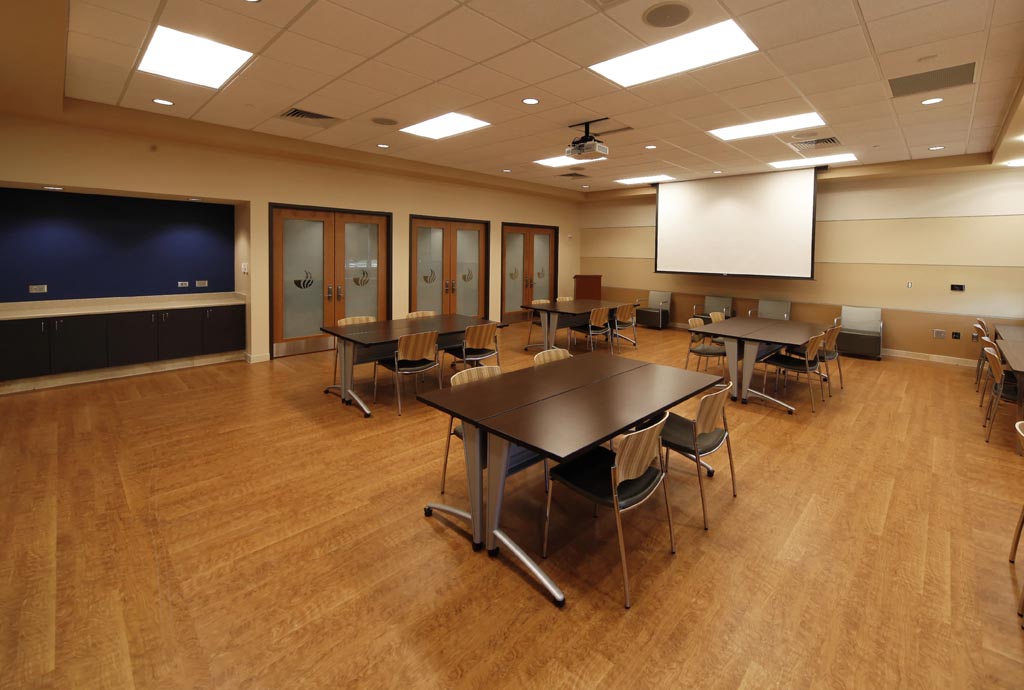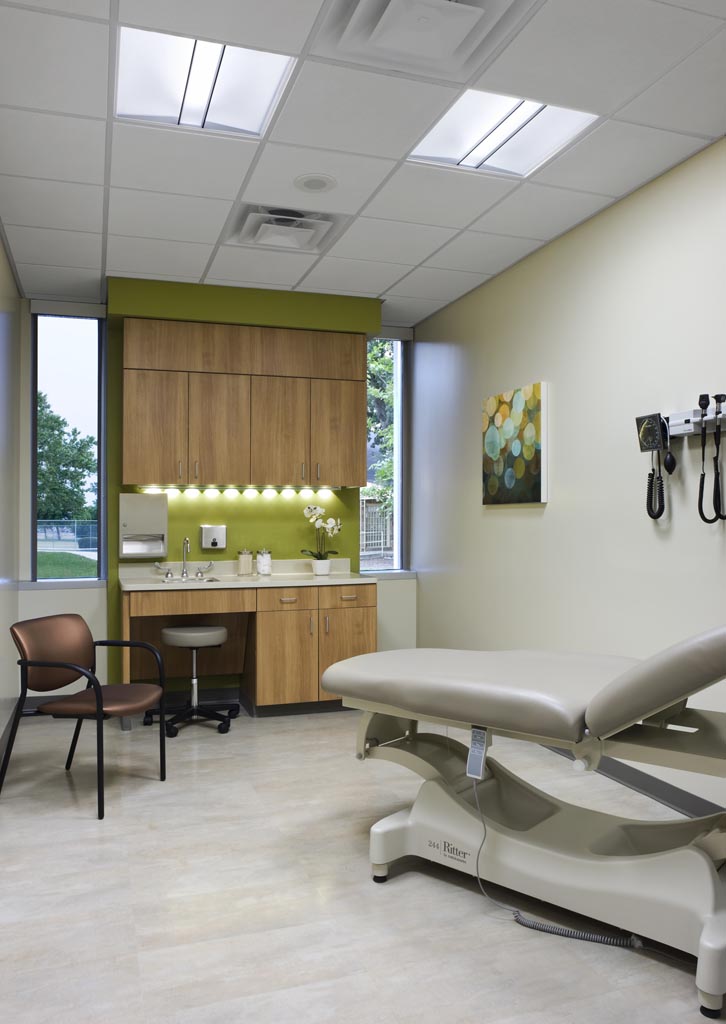Vinyl vs. Linoleum Flooring
The vinyl flooring vs. linoleum comparison is one filled with many similarities. From cost and cleanup to applications and aesthetic value, the vinyl flooring vs. linoleum debate is for the most part pretty even keeled. There are however a few key differences between the two flooring options that should definitely not be ignored — especially as you assess which quality flooring product will be the best fit for your next interior design project.

Georgia State University featuring InGrained: Boardroom Oak 11232
Vinyl flooring — a contemporary yet classic flooring product — is one of the most versatile flooring options on the market today, not only in terms of its durability, but also with regards to its design possibilities. As a result, interior designers routinely rely on vinyl flooring to be a durable and design-rich flooring option in their commercial design projects.
Linoleum, on the other hand, represents the old guard of flooring options. Made from linseed oil, linoleum was created in the 1860s and up until a few decades ago was revered for its natural qualities and affordability. These days, however, linoleum is known as a somewhat aged flooring product most commonly be found in schools and hospitals. Having begun to lose its luster in the interior design industry, linoleum is now viewed by many design experts as the vinyl flooring of old.
In order to truly understand the vinyl flooring vs. linoleum comparison, it’s helpful to look at the following quantifiable qualities: Look & Style, Durability & Stability, Applications and Cost.
Look & Style
The difference in design versatility between vinyl flooring vs. linoleum is astounding.
Linoleum is extremely limited in its design options. Unlike vinyl, which authentically replicates the natural look of wood and stone, linoleum is essentially a dye product capable of achieving a simple, yet sometimes vivid color selection. Additionally, linoleum can be susceptible to color change — which is most often referred to the “yellowing” or “bloom” of the flooring product.
Vinyl, on the other hand, is limitlessly customizable and designable — giving you the versatility you need to complete any interior design project.
Linoleum Flooring
- Limited design options
- Susceptible to color change
Vinyl Flooring
- Limitlessly customizable and designable
- Can replicate naturally the look and style of various flooring materials like concrete, marble, stone and wood

Juanita Craft Recreation Center in Dallas, TX featuring HardCore: Metallon Molten Steel 87207E
Durability & Stability
The durability discussion is where vinyl flooring and linoleum begins to separate themselves from one another. The biggest differentiator, however, involves the maintenance each flooring product needs to maintain a long-lasting aesthetic.
While both flooring options are easy to maintain, linoleum is susceptible to moisture damage and requires additional maintenance upon installation. Vinyl flooring, on the other hand, is a non-porous material; the result is a flooring that is resistant to high moisture and spills.
Both vinyl flooring and linoleum are fairly easy to install, however while linoleum is starting to introduce tile options, it is mostly available as a sheet product making installation efforts slightly more complex than installing luxury vinyl tile and plank.
Installers will commonly seal linoleum to ensure greater protection against moisture, whereas vinyl requires no such initial maintenance. Vinyl flooring is a flexible material that can form to the substrate and won’t warp or buckle, while linoleum is slightly more problematic. If linoleum is installed on an uneven substrate, this may influence its long-term durability—thereby causing the flooring to bend, crack and warp over time.
Additionally, linoleum is rather limited in terms of the cleaning products that should be used for maintenance. Because linoleum is made of natural materials, the type of cleaner used must be sensitive so as not to corrode the flooring. Typically, an acrylic coat or wax is applied to linoleum to protect it from cleaning products. With vinyl, this type of additional maintenance is not required.
Linoleum Flooring
- Susceptible to moisture damage
- Requires additional maintenance upon installation
Vinyl Flooring
- More water resistant and ideal for higher-moisture areas
- Does not require an acrylic coat or wax for protection from cleaning products
Cost
A cost comparison of vinyl flooring vs. linoleum is fairly head to head.
- Luxury vinyl—Vinyl flooring can cost anywhere from $2-$5 per square foot for commercial-grade material, not including installation.
- Linoleum — Linoleum is comparable to vinyl flooring, often times falling within the same pricing range. When factoring in the additional maintenance needed for linoleum, luxury vinyl is a dependable and affordable flooring solution.
Linoleum Flooring
- Comparable pricing to vinyl prior to installation
- Requires additional maintenance costs
Vinyl Flooring
- Vinyl can often be priced similarly to linoleum, but offers much higher value when factoring in ease of maintenance
Applications
As mentioned earlier, linoleum is used only sparingly by interior designers working in commercial installation projects related to education and healthcare.
On the contrary, vinyl flooring is ideal for almost any commercial design project thanks to its multi-faceted and cross-purpose functionality. Whether it’s healthcare, education, multi-family, corporate, retail or hospitality, vinyl performs particularly well in areas susceptible to high moisture and humidity.
Linoleum Flooring
- Limited to certain applications within education and healthcare industries
Vinyl Flooring
- Multi-faceted, cross-purpose functionality for commercial industries
Look & Style
Cost
Durability & Stability
Applications
If you found this comparison of luxury vinyl vs. linoleum flooring helpful, you can find more information on our blog, including this post — “Why is Vinyl Flooring The Fastest Growing Material?” Feel free to contact us to find out more about why Parterre has become the leader in modern, high-quality premium vinyl flooring. We would love to work with you on your next project.
Parterre Flooring
Read MorePolished Concrete vs. Vinyl Flooring
Polished Concrete vs. Vinyl Flooring Polished concrete vs. vinyl flooring. It’s not an easy decision, considering both provide an excellent solution for commercial flooring. The look of concrete floors has been a growing trend for commercial interiors.
Chevron and Herringbone
Break the Pattern of Commercial Flooring You can add more flair to your commercial flooring by breaking from the look of traditional straight-line, square, and diagonal patterns. Eye-catching looks like chevron and herringbone will dot the designer landscape in 2024.